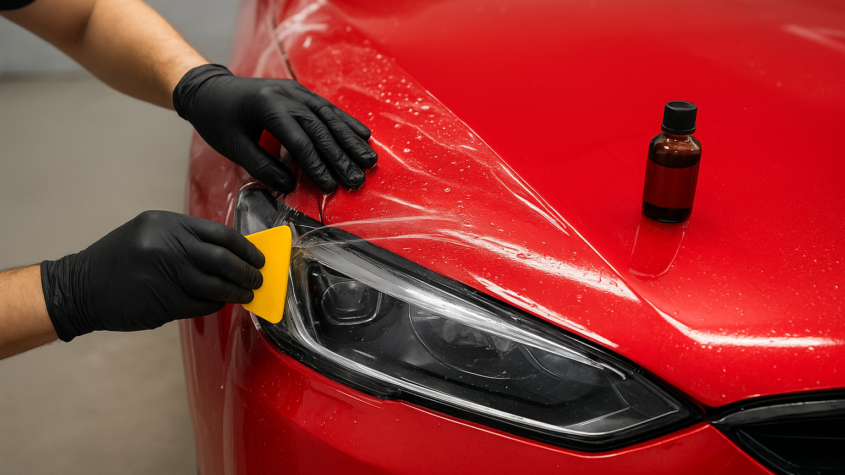
Ceramic coating car care is a solution designed to protect a vehicle’s paint by forming a durable, protective layer bonded at the molecular level. It offers long-lasting resistance against dirt, UV rays, and minor scratches, making the car easier to clean and maintain. Unlike traditional waxes, ceramic coatings do not wear off quickly, providing sustained protection.
The effectiveness of ceramic coatings depends on factors such as the quality of the product and the application process. While it is not necessary for every car or owner, those seeking to keep their vehicle’s appearance intact with less frequent cleaning may find it valuable. Understanding its benefits and limitations helps in deciding if ceramic coating is a worthwhile investment for a specific use case.
What Is Ceramic Coating for Cars?
Ceramic coating is a liquid polymer applied to the exterior of a vehicle to protect and enhance the paint. It forms a hard, protective layer that is chemically bonded to the surface, offering durability beyond traditional waxes or sealants.
This coating improves resistance to contaminants, minor scratches, and environmental damage, while also making the vehicle easier to clean and maintain.
How Ceramic Coating Works
Ceramic coating chemically bonds with the car’s paint at a molecular level, creating a rigid, transparent shield. This shield repels water, dirt, and various chemicals, helping keep the surface cleaner for longer periods.
The coating is made of silicon dioxide (SiO2) or sometimes combined with graphene for enhanced strength. Once cured, it forms a hydrophobic surface that causes water and grime to bead and slide off.
Professional application ensures even coverage and proper curing, which are essential to maximize the coating’s protective properties and longevity.
Benefits of Ceramic Coating
Ceramic coating offers long-lasting protection, often lasting several years versus weeks or months for wax. It reduces the risk of damage from UV rays, tree sap, bug residue, and road salts.
The coating also resists minor scratches and swirl marks better than traditional protections. It improves shine and depth of the paint, creating a glossy, wet-look finish.
Cleaning becomes simpler because dirt and water slide off more easily. This lowers the frequency and effort required for washing, saving time and reducing the risk of paint damage from cleaning.
Limitations of Ceramic Coating
Ceramic coatings do not make a car scratch-proof or immune to chips from road debris. They protect against minor abrasions but cannot prevent all forms of paint damage.
Application requires surface preparation, including polishing to remove imperfections. Neglecting this step can trap blemishes under the coating, making them more visible.
The initial cost can be high compared to traditional waxes. Also, professional installation is typically necessary for optimal results, limiting DIY options.
Ceramic coatings require maintenance further on, such as occasional washing with specialized products, to preserve their effectiveness.
Applying Ceramic Coating to Your Car
Applying ceramic coating requires careful surface preparation, precise application techniques, and awareness of common pitfalls. Proper execution ensures a durable, glossy finish that protects the vehicle’s paint for years. The process involves cleaning, inspection, and detailed steps that must be followed methodically.
Preparation and Surface Cleaning
The surface must be impeccably clean before applying ceramic coating. This starts with washing the car thoroughly using a pH-neutral car shampoo to remove dirt and grime. After washing, a clay bar treatment helps remove embedded contaminants that washing alone cannot eliminate.
Next, the paint should be inspected under proper lighting for scratches, swirl marks, or oxidation. If defects exist, paint correction or polishing is necessary to achieve a smooth base. Any residual oils or polishing compounds must be removed using an isopropyl alcohol (IPA) wipe to ensure the coating bonds correctly.
Dry the vehicle completely with microfiber towels. Work in a shaded area or indoors to prevent debris and water spots from contaminating the surface during application.
Application Process Steps
Begin by applying the ceramic coating sparingly onto an applicator pad or microfiber cloth. Work on small sections, about 2×2 feet, to maintain control. Spread the coating evenly using overlapping back-and-forth or circular motions, ensuring full coverage without streaking.
After application, wait the recommended flash time, usually 1–3 minutes, for the coating to begin bonding but not dry completely. Then, gently buff the area with a clean microfiber towel to remove any excess product or high spots that could cause unevenness or hazing.
Repeat this process systematically across the entire car, avoiding missed spots or heavy buildup. Multiple layers may be applied if allowed by the product instructions, increasing durability and depth of shine.
Common Mistakes to Avoid
Applying ceramic coating on a surface that isn’t properly prepared will reduce durability and effectiveness. Skipping paint correction or failing to decontaminate the surface leads to poor adhesion and uneven results.
Using too much product is a frequent error. Excessive coating results in streaks, streaking, or a cloudy finish that can be difficult to remove. It is better to apply thin, controlled layers.
Applying the coating under direct sunlight or on a hot surface accelerates evaporation, causing poor bonding and visible imperfections. Maintaining consistent flash times and avoiding layer overlap prevent uneven coverage and streakiness.
Patience and attention to detail are essential for a successful DIY ceramic coating application.
British Virgin Islands Company Registration Guide for Seamless Offshore Setup
Registering a company in the British Virgin Islands (BVI) is a straightforward process tha…









